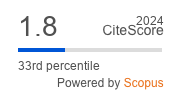Footstep Recognition Using Mel Frequency Cepstral Coefficients and Artificial Neural Network
Footstep Recognition Menggunakan Mel Frequency Cepstral Coefficients dan Artificial Neural Network
Abstract
Footstep recognition is relatively new biometrics and based on the learning of footsteps signals captured from people walking on the sensing area. The footstep signals classification process for security systems still has a low level of accuracy. Therefore, we need a classification system that has a high accuracy for security systems. Most systems are generally developed using geometric and holistic features but still provide high error rates. In this research, a new system is proposed by using the Mel Frequency Cepstral Coefficients (MFCCs) feature extraction, because it has a good linear frequency as a copycat of the human hearing system and Artificial Neural Network (ANN) as a classification algorithm because it has a good level of accuracy with a dataset of 500 recording footsteps. The classification results show that the proposed system can achieve the highest accuracy of validation loss value 57.3, Accuracy testing 92.0%, loss value 193.8, and accuracy training 100%, the accuracy results are an evaluation of the system in improving the foot signal recognition system for security systems in the smart home environment.
Downloads
References
M. Gunawan, T. Aditya, D. T. Geodesi, F. Teknik, and U. G. Mada, “Analitik geovisual pola kejadian dan pergerakan kriminalitas berbasis data media sosial 1,2,” Pros. Semin. Nas. GEOTIK, pp. 335–345, 2019.
B. P. Statistik, Statistik Kriminal 2016, vol. 111, no. 479. 1965.
J. E. Riwurohi, J. E. Istiyanto, K. Mustofa, and A. E. Putra, “People Recognition through Footstep Sound Using MFCC Extraction Method of Artificial Neural Network Back Propagation,” Int. J. Comput. Sci. Netw. Secur., vol. 18, no. 4, pp. 28–35, 2018.
R. V. Rodríguez, R. P. Lewis, J. S. D. Mason, and N. W. D. Evans, “Footstep recognition for a smart home environment,” Int. J. Smart Home, vol. 2, no. 2, pp. 95–110, 2008.
S. Pan and N. Wang, “Indoor Person Identification through Footstep Induced Structural Vibration,” Proc. 16th Int. Work. Mob. Comput. Syst. Appl., pp. 81–86, 2015.
S. M. Shaharum, S. Aniza, K. Sundaraj, R. Palaniappan, and K. Helmy, “Classification of asthma severity levels by wheeze sound analysis,” Proc. - 2016 IEEE Conf. Syst. Process Control. ICSPC 2016, no. December, pp. 172–176, 2017.
I. H. Kim, J. H. Bong, J. Park, and S. Park, “Prediction of driver’s intention of lane change by augmenting sensor information using machine learning techniques,” Sensors (Switzerland), vol. 17, no. 6, pp. 1–18, 2017.
T. M. Rajisha, A. P. Sunija, and K. S. Riyas, “Performance Analysis of Malayalam Language Speech Emotion Recognition System Using ANN/SVM,” Procedia Technol., vol. 24, pp. 1097–1104, 2016.
H. H. Nuha, A. Balghonaim, B. Liu, M. Mohandes, M. Deriche, and F. Fekri, “Deep Neural Networks with Extreme Learning Machine for Seismic Data Compression,” Arab. J. Sci. Eng., 2020.
M. Moneykumar, E. Sherly, and W. S. Varghese, “Isolated Word Recognition System for {M}alayalam using Machine Learning,” Proc. 12th Int. Conf. Nat. Lang. Process., pp. 158–165, 2015.
H. Nuha, A. Balghonaim, M. Mohandes, B. Liu, and F. Fekri, “Seismic data compression using deep neural network predictors,” in SEG International Exposition and Annual Meeting 2019, 2020.
S. Sen, A. Dutta, and N. Dey, “Speech processing and recognition system,” SpringerBriefs Appl. Sci. Technol., pp. 13–43, 2019.
H. Nuha, M. Deriche, and M. Mohandes, “Bilateral filters with elliptical Gaussian kernels for seismic surveys denoising,” in 2019 5th International Conference on Frontiers of Signal Processing, ICFSP 2019, 2019.
D. Bhattacharyya, R. Ranjan, F. Alisherov, and C. Minkyu, “Biometric Authentication : A Review Biometric Authentication : A Review,” Int. J. Trend Res. Dev., vol. 2(4), no. September 2009, pp. 113–123, 2014.
M. Mohandes, A. Hussain, P. Khan, and H. Nuha, “Non-Vital Privacy Compromise for Improved Services in Pilgrimage Seasons,” in 2019 IEEE RFID Conference, 2019.
T. K. Ghazali and N. H. Zakaria, “Security, comfort, healthcare, and energy saving: A review on biometric factors for smart home environment,” J. Comput., vol. 29, no. 1, pp. 189–208, 2018.
I. Mulia Insan, Parman Sukarno, Rahmat Yasirandi, “Multi-Factor Authentication Using a Smart Card and Fingerprint (Case Study: Parking Gate),” Indones. J. Comput., vol. 4, no. August, pp. 55–66, 2019.
X. Wang, T. Yang, Y. Yu, R. Zhang, and F. Guo, “Footstep-Identification System Based on Walking Interval,” IEEE Intell. Syst., vol. 30, no. 2, pp. 46–52, 2015.
S. Narang and M. Divya Gupta, “Speech Feature Extraction Techniques: A Review,” Int. J. Comput. Sci. Mob. Comput., vol. 4, no. 3, pp. 107–114, 2015.
F. Liu and Q. Jiang, “Research on recognition of criminal suspects based on foot sounds,” Proc. 2019 IEEE 3rd Inf. Technol. Networking, Electron. Autom. Control Conf. ITNEC 2019, no. Itnec, pp. 1347–1351, 2019.
P. J. Chaudhary and K. M. Vagadia, “A Review Article on Speaker Recognition with Feature Extraction,” Int. J. Emerg. Technol. Adv. Eng., vol. 5, no. 2, pp. 94–97, 2015.
M. Ariyanto et al., “Finger movement pattern recognition method using artificial neural network based on electromyography (EMG) sensor,” Proc. 2015 Int. Conf. Autom. Cogn. Sci. Opt. Micro Electro-Mechanical Syst. Inf. Technol. ICACOMIT 2015, pp. 12–17, 2016.
H. Li, Z. Zhang, and Z. Liu, “Application of artificial neural networks for catalysis: A review,” Catalysts, vol. 7, no. 10, 2017.
Copyright (c) 2020 Jurnal RESTI (Rekayasa Sistem dan Teknologi Informasi)

This work is licensed under a Creative Commons Attribution 4.0 International License.
Copyright in each article belongs to the author
- The author acknowledges that the RESTI Journal (System Engineering and Information Technology) is the first publisher to publish with a license Creative Commons Attribution 4.0 International License.
- Authors can enter writing separately, arrange the non-exclusive distribution of manuscripts that have been published in this journal into other versions (eg sent to the author's institutional repository, publication in a book, etc.), by acknowledging that the manuscript has been published for the first time in the RESTI (Rekayasa Sistem dan Teknologi Informasi) journal ;








